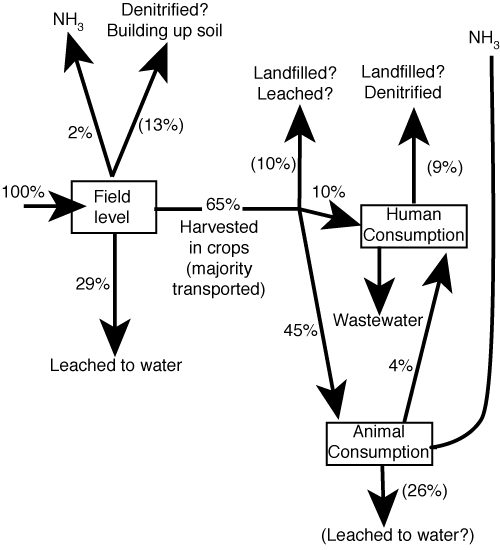


 |  |  | 17.4 Sources |
The natural sources of nutrients (streams, lakes, rivers) derived from natural (erosion) and human activity. Today the flux of nutrients from their sources to the coast is strongly influenced by anthropogenic activities. Human population growth does not cease in the near future and in all already high agricultural production regions (such as the U.S., central Europe, but in particular in India and China) the application of fertilizers will in crease (Figure 6). In addition, clear-cutting trees, drainage of wetlands, fertilising fields and meadows, intensive husbandry, building dams and towns, in essence all anthropogenic activities, contribute to the prevailing picture of cultural eutrophication (see Introduction). Only a small fraction of applied fertilizers ends up in human food while most is discharged to streams and the atmosphere (Figure 7). The main nutrient sources are diffuse with agriculture as the contributor. Point sources such as towns play a moderate role in the complex scenario of nutrient discharge. The so far strong dedication to reduce eutrophication through point sources such as towns and factories implies that the most important sources for eutrophication have not been sufficiently focussed upon. Even in industrialised countries the main contribution of nutrients derives from agriculture, husbandry and forestry.


As an example we select intensive husbandry with Denmark as an example. Here are 13 million pigs that produce faeces and urine corresponding to 3 person equivalents. Pig farms alone produce probably 6 times more nutrients in Denmark then its population, which is connected to sewer systems. In addition there is the remaining husbandry and extensive agriculture production. In total, person equivalents of more than hundred million persons are discharged into the Danish aquifer and the coastal zone. Some of these millions are channelled through sewer systems, but the majority is discharged without significant limitation. Eutrophication of Danish coastal waters is thus not surprising. Locally towns and smaller settlements may cause it, but on a larger scale it is the agricultural practice, the intensity of crop growing and our choice of food (meat vs. vegetables and cereals) that determine most of cultural eutrophication. Sustainability in the coastal zone is thus, bye and large, a question of how we produce food, which food we prefer and what environmental constrains we select for the environment we live in.
Recent investigations indicate that 30% or more of the annual nitrogen supply can come from the atmosphere and burning of oil/gas and intensive husbandry are the reason. Everybody contributes to this large-scale eutrophication. Point sources of nitrogen are of minor significance (in the case of Denmark only 3%) while 66% derive from river discharge with agriculture as the main contributor. Should we attempt to reduce cultural eutrophication we must start where the gain is greatest. Thus we have to attempt to reduce the diffuse emission of nutrients and not focus mainly on the point sources that do only play a minor role in the total picture. This implies that the emissions from agriculture into aquifers and the atmosphere have to be reduced and regulated. There is no indication that this can take place in the near future. Little public debate about this matter exists and attempts to create such a debate in the media appear to result in no major public interest. We have to confront us with this debate if we wish to have an adequate opinion about sustainability.
 |  |  | 17.4 Sources |